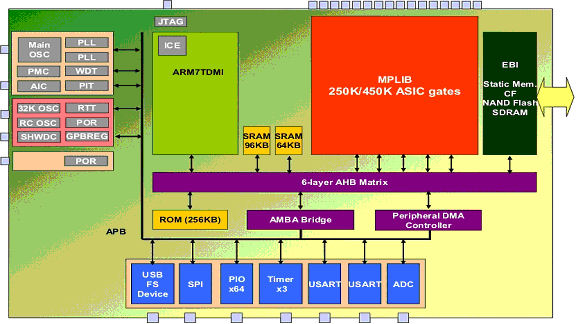In June Atmel announced the Customizable Atmel Processor (CAP), a family of customizable microcontrollers, and two initial devices. Customization in the CAP is achieved via a gate array block in which users can implement functions ranging from processor cores and peripherals to algorithm accelerators. Atmel intends the CAP devices to be used in industrial, consumer, medical, and automotive applications, as replacements for the microcontroller-FPGA combinations often used in these applications.
CAP devices are manufactured in a 130 nm process and feature a pre-fabricated ARM7 or ARM9 core, peripherals, and busses. In addition, the devices include a metal-programmable gate array block providing around 250K-500K ASIC gates, and available to users as masked programmed logic. Atmel provides users with pre-verified hardware IP blocks for various I/O interfaces and peripherals, such as CAN, Ethernet MAC, and USB, and engines for cryptography algorithms. Users can also incorporate their own logic into the gate array block, for example to implement DSP algorithm accelerators or custom interfaces. Atmel provides users with an emulation platform to validate their designs.

Figure 1. Atmel’s CAP7 device featuring an ARM7 core and a metal-programmable block.
CAP devices cost $6-13 each in 100K quantities. (They are significantly more expensive in smaller quantities, due to minimum order sizes of $250K for the ARM7-based version and $1M for the ARM9-based version.) If Atmel’s performance claims hold, then the CAP devices may offer significant cost, throughput, and energy efficiency gains over the CPU-FPGA combinations employed in a variety of medium-volume applications. Compared with standard microcontroller chips, the flexibility to implement custom peripherals, algorithm accelerators, and even additional processor cores will likely allow CAP designs to achieve superior integration and performance. However, prospective CAP users face some critical unknowns. Most notable among these are the ease of use and robustness of the design methodology and tools provided by Atmel for implementing and verifying custom functions in the gate array block. Atmel must also convince potential CAP users that communication bottlenecks between the programmable logic, CPU core, and memory will not hamper performance—a common pitfall when accelerators are used in conjunction with off-the-shelf processors. Atmel states that the multiplicity of busses and DMA channels on CAP chips will provide sufficient bandwidth for demanding applications.
Atmel’s CAP devices are most likely to be appropriate for medium volume applications, where they may provide gains in throughput, cost and energy efficiency relative to FPGA-based solutions, and cost and time-to-market benefits relative to ASIC-based solutions.
The CAP7 (featuring ARM7) and CAP9 (featuring ARM9) are available today. Atmel’s CAP emulation board will be available in August 2007 and will cost $3,500.


Add new comment